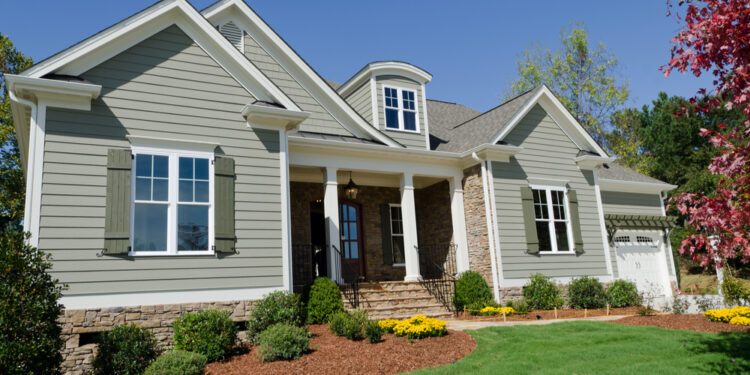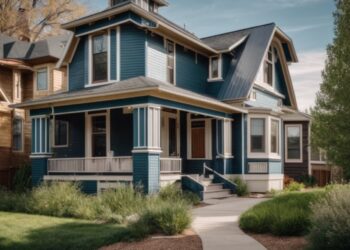Step into the world of exterior siding and trim, where your home's facade comes to life with a touch of personality and style. From durable materials to enhancing aesthetics, this topic delves into the essentials of making your home stand out.
 . Misaligned panels can affect the aesthetic appeal of the house and compromise the integrity of the installation.
. Misaligned panels can affect the aesthetic appeal of the house and compromise the integrity of the installation.

Types of Exterior Siding
When it comes to exterior siding, there are several materials to choose from, each with its own unique characteristics and benefits. The most common types of exterior siding include vinyl, wood, fiber cement, and metal.Vinyl Siding
Vinyl siding is a popular choice due to its affordability, low maintenance requirements, and wide range of colors and styles. It is also resistant to rot, insect damage, and fading. However, vinyl siding can crack or warp in extreme temperatures and may not have the same aesthetic appeal as natural materials like wood.Wood Siding
Wood siding offers a classic, natural look that can enhance the overall appearance of a home. It is durable and can be painted or stained in various colors. However, wood siding requires regular maintenance, including painting or staining, to prevent rot, mold, and insect damage. It is also more susceptible to fire than other siding materials.Fiber Cement Siding
Fiber cement siding is a durable and low-maintenance option that offers the look of wood without the susceptibility to rot and insects. It is resistant to fire, moisture, and pests, making it a popular choice for homeowners looking for a long-lasting siding option. However, fiber cement siding can be more expensive than vinyl or wood siding.Metal Siding
Metal siding, such as steel or aluminum, is known for its durability, strength, and resistance to fire, insects, and rot. It requires minimal maintenance and can last for many years. However, metal siding can dent or scratch easily, and it may not offer the same visual appeal as other siding materials.Choosing the Right Exterior Siding
When it comes to selecting the right exterior siding for your home, there are several factors to consider. From durability to aesthetics, each aspect plays a crucial role in making the best choice for your property.Factors to Consider When Selecting Exterior Siding
- Material: Different siding materials offer varying levels of durability, maintenance requirements, and aesthetic appeal. Consider factors like cost, maintenance, and longevity when choosing the material.
- Architectural Style: The siding should complement the architectural style of your home to enhance its overall look and curb appeal.
- Climate: The climate of your region can significantly impact the performance and longevity of the siding material. Choose a material that can withstand the specific weather conditions in your area.
- Maintenance: Some siding materials require more maintenance than others. Consider your willingness and ability to maintain the siding regularly when making a choice.
- Budget: Determine your budget for the siding project, including material cost, installation, and long-term maintenance expenses.
Comparing the Durability of Different Siding Materials
- Vinyl Siding: Vinyl siding is known for its low maintenance and durability. It is resistant to rot, insects, and moisture, making it a popular choice for many homeowners.
- Fiber Cement Siding: Fiber cement siding offers excellent durability and resistance to fire, moisture, and pests. It is a long-lasting option that requires minimal maintenance.
- Wood Siding: Wood siding provides a natural and timeless look but requires more maintenance to prevent rot, warping, and insect damage. Proper maintenance can help extend the lifespan of wood siding.
- Metal Siding: Metal siding, such as aluminum or steel, is durable, weather-resistant, and low maintenance. It can withstand harsh weather conditions and is a long-lasting option for many homes.
The Impact of Climate on Siding Choices
- Hot and Humid Climates: In hot and humid climates, siding materials that are resistant to moisture, mold, and mildew are essential. Consider options like vinyl or fiber cement siding for better durability.
- Cold and Wet Climates: In cold and wet climates, siding materials that can withstand freezing temperatures, snow, and ice are crucial. Metal siding or fiber cement siding are good choices for these conditions.
- Extreme Weather Conditions: For areas prone to extreme weather conditions like hurricanes or tornadoes, impact-resistant siding materials like fiber cement or metal are recommended for better protection.
Installing Exterior Siding
Installing exterior siding is a crucial step in enhancing the appearance and protection of your home. Proper installation not only improves curb appeal but also helps in insulating your home and protecting it from the elements.Proper Insulation:When installing exterior siding, it is important to ensure proper insulation. Insulation helps in maintaining a comfortable temperature inside the house, reducing energy costs, and preventing moisture-related issues such as mold and mildew. Without adequate insulation, your home may be susceptible to drafts, heat loss, and potential damage.Common Challenges Faced During Siding Installation: 1. Uneven Surface One of the common challenges faced during siding installation is dealing with uneven surfaces. It is important to prepare the surface properly by fixing any underlying issues and ensuring a smooth base for the siding. 2. Weather Conditions Weather conditions can impact the installation process. Extreme temperatures, high winds, or rain can affect the siding installation, leading to delays or potential damage. It is important to schedule the installation during favorable weather conditions. 3. Proper Alignment Ensuring proper alignment of the siding panels is essential for a seamless finishImportance of Proper Installation
Proper installation of exterior siding is crucial for the overall durability and performance of your home. Here are the steps involved in installing exterior siding:- Prepare the Surface: Inspect the exterior surface for any damage or rot. Repair and replace any damaged areas before proceeding with the installation.
- Install Insulation: Add insulation to improve energy efficiency and protect against moisture. Proper insulation can also help in reducing noise transmission.
- Choose the Right Siding Material: Select a siding material that suits your home's style and climate. Popular options include vinyl, wood, fiber cement, and metal.
- Measure and Cut: Accurately measure the dimensions of the siding panels and trim pieces before cutting them to fit the specific areas of your home.
- Start Installation: Begin installing the siding from the bottom up, ensuring proper alignment and securing each panel according to manufacturer guidelines.
- Finish with Trim: Complete the installation by adding trim pieces around windows, doors, and corners for a polished look.
Maintaining Exterior Siding
Regular maintenance of exterior siding is crucial to ensure its longevity and appearance. By performing routine tasks and cleaning, you can preserve the integrity and aesthetic appeal of your home's siding. Timely repairs are also essential to prevent any damage from escalating and causing more extensive issues.Cleaning and Maintaining Vinyl Siding
Vinyl siding is relatively low maintenance, but it still requires regular cleaning to keep it looking its best. Here are some tips for maintaining vinyl siding:- Regularly wash the siding with a mixture of water and mild detergent to remove dirt and grime.
- Avoid using harsh chemicals or abrasive tools that can damage the vinyl surface.
- Inspect for any signs of mold or mildew and treat it promptly to prevent further growth.
- Trim any vegetation that may be too close to the siding to prevent damage and maintain airflow.
Maintaining Wood Siding
Wood siding requires more upkeep compared to vinyl or other materials. To maintain wood siding, follow these maintenance tasks:- Regularly inspect for signs of rot, mold, or pests, and address any issues immediately.
- Refinish or repaint wood siding every few years to protect it from the elements and maintain its appearance.
- Keep the siding clean by washing it with a gentle cleaner and rinsing thoroughly.
- Apply a protective sealant to prevent moisture penetration and prolong the life of the wood.
Maintaining Fiber Cement Siding
Fiber cement siding is durable and low maintenance, but it still requires some care to keep it in top condition. Here are some maintenance tips for fiber cement siding:- Inspect the siding regularly for any cracks, chips, or signs of damage, and repair as needed.
- Clean the siding with a mixture of water and mild soap to remove dirt and debris.
- Avoid using high-pressure washers that can damage the siding and compromise its integrity.
- Consider repainting the siding every 10-15 years to refresh its appearance and protect it from the elements.
Exterior Trim Options
When it comes to exterior trim, there are various options available to enhance the overall look of your home. Trim plays a crucial role in adding architectural detail, creating visual interest, and providing a finishing touch to the exterior of a house.Types of Exterior Trim
- Wood Trim: A classic choice that offers a natural look and can be easily customized to fit the style of your home.
- Vinyl Trim: Low-maintenance and durable, vinyl trim comes in a wide range of colors and styles.
- Fiber Cement Trim: Resistant to rot, insects, and fire, fiber cement trim is a popular option for its longevity and versatility.
- PVC Trim: Known for its durability and weather resistance, PVC trim is a great choice for areas prone to moisture exposure.
Role of Trim in Enhancing Aesthetics
Exterior trim plays a crucial role in enhancing the aesthetics of a home by adding depth, character, and definition to the exterior facade. It can help highlight architectural features, create visual contrast, and tie together different design elements for a cohesive look.Choosing the Right Trim
When selecting exterior trim to complement your siding, consider factors such as the architectural style of your home, the color scheme, and the level of maintenance you are willing to undertake. Choose trim that complements the siding material and color, while also adding visual interest and curb appeal to your home.Painting and Finishing Exterior Trim
When it comes to enhancing the appearance of your home's exterior, painting and finishing the trim is a crucial step. Not only does it provide protection against the elements, but it also adds a polished look to your property.Choosing the Right Paint Color for Trim
Selecting the perfect paint color for your exterior trim can significantly impact the overall aesthetic of your home. Consider the following tips when choosing a paint color:- Take into account the existing color of your siding to ensure a cohesive look.
- Opt for a color that complements the style and architecture of your home.
- Consider the surrounding landscape and neighborhood aesthetic for inspiration.
- Sample the paint colors on a small area of the trim to see how they look in different lighting conditions.
Importance of Proper Preparation Before Painting
Proper preparation is key to a successful paint job that will last for years to come. Before painting your exterior trim, make sure to:- Clean the trim thoroughly to remove dirt, dust, and grime.
- Repair any damage such as cracks, holes, or peeling paint.
- Sand the surface to create a smooth and even base for the paint to adhere to.
- Apply a primer to improve paint adhesion and durability.















